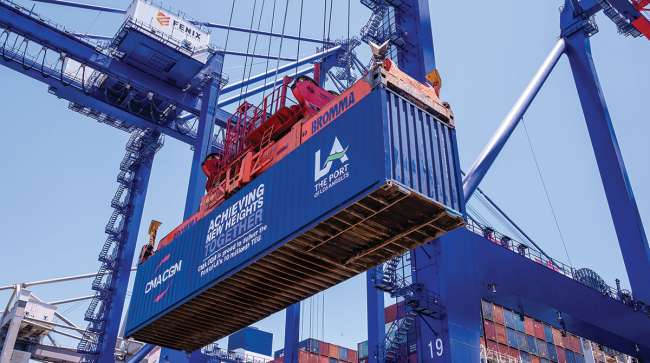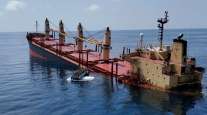Senior Reporter
Executive Order on Competition Mostly Praised in Shipping Community

[Stay on top of transportation news: Get TTNews in your inbox.]
President Joe Biden’s July 9 signing of a sweeping executive order to increase competition and reduce the unprecedented congestion in the supply chain is gaining the support of leaders at the Federal Maritime Commission and trade associations.
Biden’s order is aimed at, among other things, sea and rail freight carriers that have seen their rates increase as the surge in U.S. demand puts increasing pressure on supply chains, causing long delays in freight transportation.
Just days after the executive order was signed, the Justice Department and Federal Maritime Commission announced on July 12 they had signed the first ever interagency Memorandum of Understanding to foster increased cooperation and communication in their respective oversight and enforcement responsibilities of the ocean liner shipping industry.

Maffei
The memo sets up a formal framework for the two agencies to continue regular discussions and review law enforcement and regulatory matters affecting competition in the shipping industry.
FMC Chairman Daniel Maffei says his independent agency already had begun investigations into reports of anti-competitive behavior among shippers.
“This memorandum between the commission and the Department of Justice supplements and strengthens the FMC’s ability to detect, address and pursue violations of the law or anti-competitive behavior by those we regulate,” Maffei said.
Paying the price
Demurrage is charged when the containers are still full and under the control of the shipping line, and have not been cleared through customs or picked up by the consignee.
Detention costs occur when the carrier’s equipment is still in use by the shipper beyond the last free day, regardless if the equipment is full or empty.
Maffei also said detention and demurrage charges are “a top priority of the agency to identify and take action against those who flout the commission’s recent interpretive rule on reasonable regulations and practices.”
Last fall, FMC began investigating detention and demurrage charges without requiring a formal complaint from a shipper, which it had required in the past.
Even before the White House announcement, the National Industrial Transportation League, which represents shippers, was calling for urgent reform.

Hedrick
“We’re especially pleased to see the administration’s calls for vigorous enforcement toward ending unfair detention and demurrage practices that are crippling the maritime supply chain,” NITL Executive Director Jennifer Hedrick said.
FMC Commissioner Carl Bentzel told Transport Topics the commission is looking at a two-track approach to investigate possible wrongdoing by those companies that may be overcharging for shipping and working with the Department of Justice to consider legal action.

Bentzel
Bentzel said large companies can pass the charges along to customers, but smaller companies are being hit hard.
“If you’re Walmart or someone with a lot of capacity, you’re probably still doing OK,” Bentzel said. “It’s the smaller shippers getting price quotes on the lack of capacity that’s 10 times what they were. We’re getting rates of more than $20,000 to ship a container from overseas.”
According to the July 8 Drewry World Container Index, the spot rate to ship a 40-foot container from Shanghai to the Port of Los Angeles is 229% higher than a year ago and it increased 5% in just the past week.
“The supply chain is stretched to a point where in the summer and fall it’s not getting to let up at all and it’s going to get worse,” Bentzel said. “This is the first time since the end of World War II where you’re seeing transportation as being a major economic challenge.”

Connor
Ports on the Pacific and Atlantic coasts are setting monthly volume records and American Association of Port Authorities CEO Chris Connor told TT that Biden’s executive order shows how stretched the ports are now, and why they must be upgraded to handle the heavier volumes that are coming in the next 10 to 15 years.
“This executive order doesn’t change the fact that ports have been underinvested in for decades,” Connor said. “We need to get federal dollars into America’s port system so that ports can build up with more resilient infrastructure for the size of the marketplace now and into the future.”
The executive order is not receiving universal praise. The Association of American Railroads, which represents all of the major freight carriers in the U.S., Mexico and Canada, called parts of the order “misguided.”

Jefferies
“Competition is alive and well in the rapidly changing freight transportation market, with nearly three-quarters of all U.S. freight shipments moving by a mode of transportation besides rail,” AAR President Ian Jefferies said. “With the logistics chain already challenged by the recovery from COVID, this executive order throws an unnecessary wrench into freight rail’s critical role in providing the service that American families and businesses rely on every day.”
AAR said specifically it objects to what the Surface Transportation Board is considering, called a forced switching rule. AAR said corporations are pushing the plan to force railroads to turn over their traffic to competing railroads at potentially below-market rates because the corporate customers are looking for cheaper ways to ship their products.
Want more news? Listen to today's daily briefing below or go here for more info:




